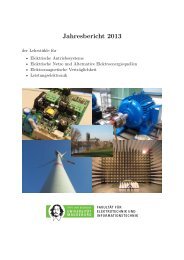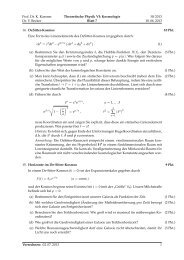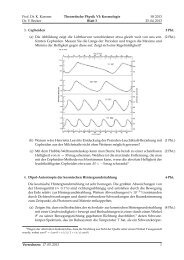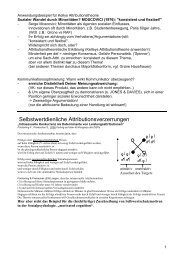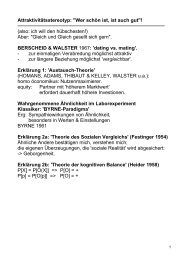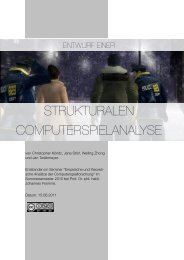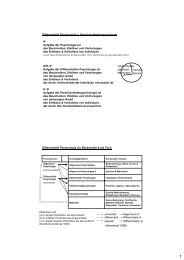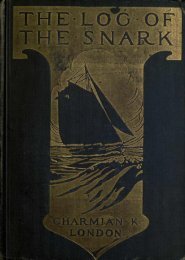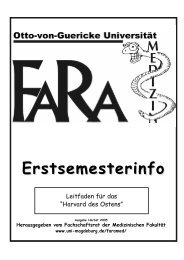Leonhard Euler, a German princess and topology O18
Leonhard Euler, a German princess and topology O18
Leonhard Euler, a German princess and topology O18
Create successful ePaper yourself
Turn your PDF publications into a flip-book with our unique Google optimized e-Paper software.
<strong>O18</strong><br />
<strong>Leonhard</strong> <strong>Euler</strong>, a <strong>German</strong> <strong>princess</strong> <strong>and</strong> <strong>topology</strong><br />
P. Pieranski<br />
1<br />
Laboratoire de Physique des Solids, Université Paris-Sud, 91405, Orsay, France<br />
“Lisez <strong>Euler</strong>, lisez <strong>Euler</strong>, c’est notre maître à tous »<br />
Pierre-Simon Laplace<br />
The 36 Topical Meeting on Liquid Crystals in Magdeburg gives me a marvellous pretext to<br />
share with you my admiration to <strong>Leonhard</strong> <strong>Euler</strong>, a scientific genius from the Age of Enlightenment.<br />
Indeed, “Lettres à une <strong>princess</strong>e d’Allemagne”, the most popular of <strong>Euler</strong>’s writings,<br />
have been addressed to the <strong>princess</strong> Sophie Friederika Charlotte Leopoldine von Anhalt-<br />
Dessau who lived here. To be more precise, Friedrich II, who in 1741 invited <strong>Euler</strong> to join the<br />
Berlin Academy, asked him to be a scientific tutor of his niece. <strong>Euler</strong> accomplished this task<br />
by writing, from Berlin, between 1760 <strong>and</strong> 1762, 234 letters in French to the <strong>princess</strong> Sophie<br />
who lived in Magdeburg.<br />
Figure 1: <strong>Leonhard</strong> <strong>Euler</strong> <strong>and</strong> the title’s page of his “Lettres à une <strong>princess</strong>e d’Allemagne”.<br />
We don’t know whether the <strong>princess</strong> red <strong>and</strong> liked <strong>Euler</strong>’s letters or not. Fortunately, they<br />
have been published in Saint Petersburg in 1768 as a book (in three volumes) (see fig.1)<br />
which immediately became a best-seller <strong>and</strong> ran through many editions [1] <strong>and</strong> translations.<br />
Even today, it can be read with pleasure <strong>and</strong> a lot of benefit not only by <strong>princess</strong>es.<br />
For scientists <strong>and</strong> scholars, it is a marvelous example of fertile scientific thought process <strong>and</strong><br />
clear expression. It is so interesting to see, from today’s perspective, how <strong>Euler</strong> tackled problems<br />
such as :<br />
93
<strong>O18</strong><br />
1. concepts of space, time or reference frame,<br />
2. the nature of sound, its speed or its production by vibrating cords <strong>and</strong> membranes,<br />
3. the nature of light <strong>and</strong> its speed, laws of reflection <strong>and</strong> refraction <strong>and</strong> their use in optical<br />
instruments such as eye, telescopes or microscopes,<br />
4. the Newton’s law of the universal gravitation <strong>and</strong> its application to the motions of planets<br />
<strong>and</strong> comets as well as for explanation of tides<br />
5. laws of the fluid’s flows <strong>and</strong> their application for sailing of ships,<br />
6. the nature of magnetism <strong>and</strong> electricity<br />
7. etc<br />
The lecture of “Lettres ...“ encouraged me to look for other <strong>Euler</strong>’s writings <strong>and</strong> a striking<br />
surprise was waiting for me. Following William Dunham [2], “<strong>Euler</strong> was a veritable Niagara,<br />
one who wrote mathematics faster then most people can absorb it“. Indeed, <strong>Euler</strong>s was<br />
the most prolific mathematician <strong>and</strong> natural scientist of all time. He wrote about 900 papers<br />
<strong>and</strong> books (about 800 pages per year). Publication of his collected works entitled “Opera Omnia“<br />
started in 1911 <strong>and</strong> is still going on. It counts about 80 volumes divided into four series :<br />
Series I Opera mathematica (In 29 volumes; 30 volume-parts)<br />
Series II Opera mechanica et astronomica (In 31 volumes; 32 volume-parts)<br />
Series III Opera physica, Miscellanea (In 12 volumes)<br />
Series IV A. Commercium epistolicum (10 volumes)<br />
Beside “Opera Omnia“ that can be found in some academic libraries, original versions of <strong>Euler</strong>’s<br />
papers are available as pdf files on Web pages of the <strong>Euler</strong> Archive<br />
(http://www.math.dartmouth.edu/~euler/). The index of this archive counts 866 entries.<br />
For the purpose of my talk here in Magdeburg, I looked for <strong>Euler</strong>’s papers dealing with topological<br />
<strong>and</strong> geometrical properties of surfaces that we use today, for example, for description<br />
of bicontinuous lyotropic phases. For instance, the definition of principal curvatures is due to<br />
<strong>Euler</strong> as it shown in Figure 2.<br />
Figure 2 : <strong>Euler</strong>’s expression for the radius of curvature of surfaces. Quotation from “Recherches<br />
sur la courbure des surfaces“ [3].<br />
94
<strong>O18</strong><br />
It is also interesting (<strong>and</strong> touching) to see (but harder to read) the paper, written in Latin, in<br />
which <strong>Euler</strong> writes for the first time his famous formula relating the number of vortices (numerus<br />
angulorum solidorum), the number of edges (numerus acierum) <strong>and</strong> the number of faces<br />
(numerus hedradum) of polyhedra (see Figure 3).<br />
Figure 3: Quotation from the original <strong>Euler</strong>’s paper on topological properties of polyhedra<br />
[4].<br />
In the <strong>Euler</strong>’s work we fin another source of <strong>topology</strong> - the celebrated problem of “Seven<br />
Kônigsberg’s bridges“ (see Figure. 4) - as well as the first definition of this new branch of<br />
mathematics :<br />
“Besides that part of geometry which deals with quantities <strong>and</strong> has always been studiously<br />
cultivated, there is another branch which is still virtually unknown; this was first mentioned<br />
by Leibniz, who called it the “geometry of position” [geometric situs]. It is concerned, he<br />
says, just with the determination of position <strong>and</strong> the investigation of its properties, <strong>and</strong> for<br />
these goals no quantities are to be considered nor any calculations with quantities used.<br />
However it has not yet been clearly defined what problems belong to this geometry of position<br />
<strong>and</strong> what method must be used to solve them. Hence, when a certain problem was recently<br />
mentioned to me which seemed to belong to geometry but did not ask for the determination of<br />
any quantities <strong>and</strong> did not admit a solution by the calculation of quantities either, I did not<br />
doubt that this belongs to the geometry of position – all the more since in its solution only<br />
positions are considered <strong>and</strong> no use is made of calculations. I propose therefore to explain<br />
here the method which I invented for the solution of this kind of problems, as a specimen of<br />
the geometry of position.”<br />
It is also striking to learn that <strong>Euler</strong> who was born in … Switzerl<strong>and</strong>, in Basel, worked almost<br />
all his life in Russia (Saint Petersburg) <strong>and</strong> Prussia (Berlin) <strong>and</strong> wrote almost all of his papers<br />
in Latin <strong>and</strong> in French. Since that time, things changed a little…<br />
How pleasant is to read in the Letter XLI these words: “Maintenant, je me vois en état<br />
d’expliquer à Votre Altesse (La Princesse Sophie) de quelle manière se fait la vision dans les<br />
yeux des hommes et de tous les animaux, ce qui est sans doute la chose la plus merveilleuse à<br />
laquelle l’esprit humain a pu pénétrer.” !<br />
95
<strong>O18</strong><br />
Figure 4 : The original drawing from the <strong>Euler</strong>’s paper on the problem of “Seven Königsberg’s<br />
bridges”. [5].<br />
Acknowledgments<br />
I would to thank François Rothen for illuminating remarks about <strong>Euler</strong>, Bernoulli’s family<br />
<strong>and</strong> the beauty of pure <strong>and</strong> applied mathematics.<br />
References<br />
[1] <strong>Leonhard</strong> <strong>Euler</strong>, “Lettres à une <strong>princess</strong>e d’Allemagne”, Presses Polytechniques et Universitaires<br />
Rom<strong>and</strong>es, Lausanne 2003 (the last edition in French)<br />
[2] William Durham, “The Master of Us All”, The Mathematical Association of America<br />
1999<br />
[3] <strong>Leonhard</strong> <strong>Euler</strong>, “Recherches sur la courbure des surfaces“, originally published in<br />
Memoires de l'academie des sciences de Berlin 16, 1767, pp. 119-143, Opera Omnia:<br />
Series 1, Volume 28, pp. 1 – 22<br />
[4] <strong>Leonhard</strong> <strong>Euler</strong>, “Elementa doctrinae solidorum“, originally published in Novi<br />
Commentarii Academiae Scientiarum Petropolitanae 4, 1758, pp. 109-140, Opera<br />
Omnia: Series 1, Volume 26, pp. 71 – 93<br />
[5] <strong>Leonhard</strong> <strong>Euler</strong>, “Solutio problematis ad Geometriam Situs pertinentis“, originally<br />
published in Commentarii Academiae Scientiarum Petropolitanae 8, 1741, p 1736,<br />
Opera Omnia: Series 1, Volume 7, p. 1<br />
96



